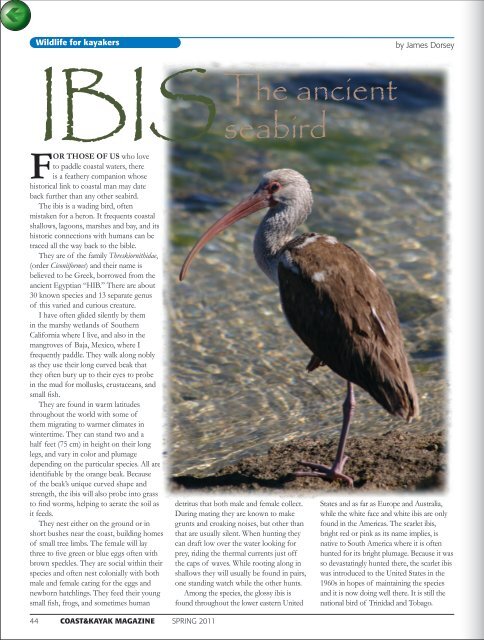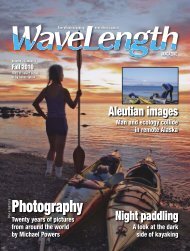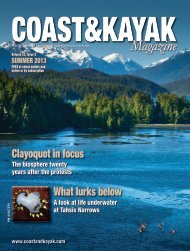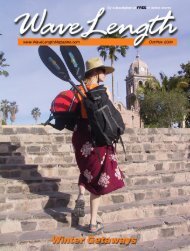a kayak - Wavelength Paddling Magazine
a kayak - Wavelength Paddling Magazine
a kayak - Wavelength Paddling Magazine
You also want an ePaper? Increase the reach of your titles
YUMPU automatically turns print PDFs into web optimized ePapers that Google loves.
Wildlife for <strong>kayak</strong>ers<br />
by James Dorsey<br />
FOR THOSE OF US who love<br />
to paddle coastal waters, there<br />
is a feathery companion whose<br />
historical link to coastal man may date<br />
back further than any other seabird.<br />
The ibis is a wading bird, often<br />
mistaken for a heron. It frequents coastal<br />
shallows, lagoons, marshes and bay, and its<br />
historic connections with humans can be<br />
traced all the way back to the bible.<br />
They are of the family Threskiornithidae,<br />
(order Ciconiiformes) and their name is<br />
believed to be Greek, borrowed from the<br />
ancient Egyptian “HIB.” There are about<br />
30 known species and 13 separate genus<br />
of this varied and curious creature.<br />
I have often glided silently by them<br />
in the marshy wetlands of Southern<br />
California where I live, and also in the<br />
mangroves of Baja, Mexico, where I<br />
frequently paddle. They walk along nobly<br />
as they use their long curved beak that<br />
they often bury up to their eyes to probe<br />
in the mud for mollusks, crustaceans, and<br />
small fish.<br />
They are found in warm latitudes<br />
throughout the world with some of<br />
them migrating to warmer climates in<br />
wintertime. They can stand two and a<br />
half feet (75 cm) in height on their long<br />
legs, and vary in color and plumage<br />
depending on the particular species. All are<br />
identifiable by the orange beak. Because<br />
of the beak’s unique curved shape and<br />
strength, the ibis will also probe into grass<br />
to find worms, helping to aerate the soil as<br />
it feeds.<br />
They nest either on the ground or in<br />
short bushes near the coast, building homes<br />
of small tree limbs. The female will lay<br />
three to five green or blue eggs often with<br />
brown speckles. They are social within their<br />
species and often nest colonially with both<br />
male and female caring for the eggs and<br />
newborn hatchlings. They feed their young<br />
small fish, frogs, and sometimes human<br />
detritus that both male and female collect.<br />
During mating they are known to make<br />
grunts and croaking noises, but other than<br />
that are usually silent. When hunting they<br />
can draft low over the water looking for<br />
prey, riding the thermal currents just off<br />
the caps of waves. While rooting along in<br />
shallows they will usually be found in pairs,<br />
one standing watch while the other hunts.<br />
Among the species, the glossy ibis is<br />
found throughout the lower eastern United<br />
States and as far as Europe and Australia,<br />
while the white face and white ibis are only<br />
found in the Americas. The scarlet ibis,<br />
bright red or pink as its name implies, is<br />
native to South America where it is often<br />
hunted for its bright plumage. Because it was<br />
so devastatingly hunted there, the scarlet ibis<br />
was introduced to the United States in the<br />
1960s in hopes of maintaining the species<br />
and it is now doing well there. It is still the<br />
national bird of Trinidad and Tobago.<br />
44 COAST&KAYAK MAGAZINE SPRING 2011
















